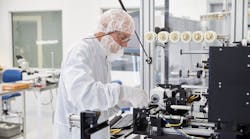What was always true is somehow not as true during a pandemic.
Suggest to a company that instead of taking the many necessary trips to a variety of locations to find the exact right site for a new plant, phone calls, and Zoom meetings will do. And mention that it will result in excellent results.
Well, that is exactly what Gary Davies, who is the head of Sandvik’s medical business unit at Sandvik Materials Technology, did.
Sandvik Materials Technology, a business unit of Stockholm-based Sandvik, wanted to expand its manufacturing of precision medical wire which is used for medical devices.
With traveling not much of an option, Davies turned to both high-tech avenues such as Zoom, and lower-tech methods such as getting on the phone.
“This was an intense process of gathering data from a wide variety of sources and then devising a structure to analyze the data to ensure that all factors were considered and weighed properly,” explains Davies.
While it was very labor-intensive, and not something that was part of his regular job, he said that when he looks back at the process he realizes that it didn’t take as much time as it would have if he had visited a number of cities which is normally part of a site selection process. And it was a lot less expensive.
Some of his more innovative information-gathering techniques were devised when he was trying to analyze the culture of the city, which is key regarding both talent attraction and retention. When talking to anyone in the area who was providing information, he probed further to find out their take on their experience living in the city as ensuring a good work-life balance is important for his workforce. He would check out LinkedIn profiles of people he spoke with to get a feel for their ties to the area. And he would read local newspapers to ensure that the facts he received matched up with what was going on in the community.
“Tucson is an ideal location for a number of reasons,” says Davies." Its high- tech hub status was very important, but it was the workforce that served these industries that really stood out. The talent pool here is used to working in a highly regulated industry and has all the basic competencies when it comes to cleanliness, record-keeping, measuring and testing. This ensures that the current, and future workforce, have a strong foundation of skills necessary for our industry and then we can provide the on-the-job training this is specific to our company.”
The presence of a workforce with such skills doesn’t happen by accident. It’s part of a strategy that Joe Snell, president, and CEO of Sun Corridor Inc. has led since 2015 to position Tucson as a place for companies to locate. The organization, which has seen 175 companies relocate or expand creating over 51,000 jobs and having a $29 billion regional economic impact since 2015, describes itself as a CEO-driven regional alliance.
“One of our particular strengths is the close relationships that have been built in our community. Our collaboration makes it possible for companies located here to provide a first-hand account of doing business in the area to companies thinking about locating here. Executives will even fly to a company's headquarters to talk about Tucson. Once a company decides to locate here they still have access to these companies to help them meet challenges and share best practices. It's a long-term relationship," explains Snell. “That advantage continues as it fosters an environment which creates synergies.”
Davies would agree with that. When he finally made an in-person visit to confirm his choice, he met with other businesses and sees future opportunities in a variety of forms especially as Tucson become a tech hub.
In addition to science companies such as Roche Tissue Diagnosis, Accelerate Diagnostics and SynCardia Systems, Inc., the area is home to several aerospace and defense companies including Raytheon Missiles & Defense, Bombardier Aerospace and Honeywell Aerospace.
“When we first started to focus in on specific industries, we realized that technology was a key competency that ran across the companies we already had,” says Snell. “We had a strong science education base and made sure to build out whatever else we needed in terms of resources.”
And the resource that is always front and center to any manufacturing company deciding where to locate a facility is the talent pipeline. Tucson is home to the University of Arizona, and Arizona State University, Northern Arizona University, Pima Community College, and other educational institutions.
“We approach our talent development strategy from the demand side, as opposed to the supply side,” says Snell. “Education was based on the current jobs that need to be filled as well as looking at what job skills were required for the future.”
The level of education available in the city struck Davies. “I was very impressed with the resources that Pima Community College had. Meeting directly with the educators, I found that in addition to a high level of interest in what we are currently doing but they were very proactive and suggested ways that they might be able to help us in the future.”
While Davis was able to find a perfect location in Tucson through a virtual site selection process that did end with an in-person visit to the city the company chose, going forward he feels site selection will become a hybrid. As most processes that were devised in reaction to the pandemic, once things return to a new normal, adjustments will again be made. “A blended model is what I feel will work best,” says Davies. “We learned a great deal doing this search virtually, and we can use that same approach to narrow down our final two or three choices and then do that final vetting in person. “.




